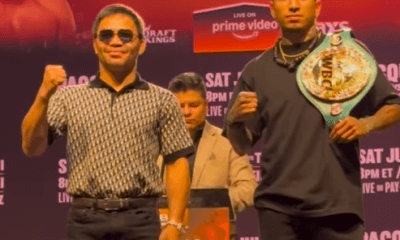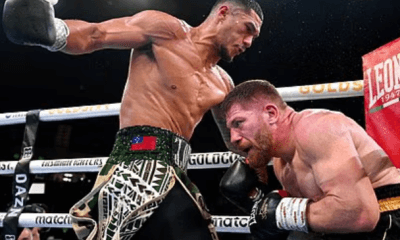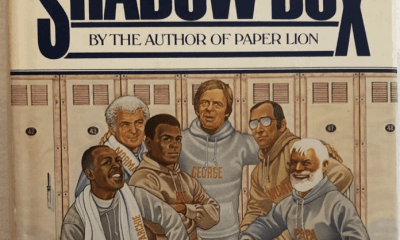Featured Articles
Rest in Peace, Harold “Hercules” Johnson
“I didn’t want that fight. I didn’t want to fight Harold Johnson. They had to pay me a lot of money to fight that animal.” – Willie Pastrano
Harold Johnson was a licensed union drummer and as his astonishing fight career wound down he could be found in clubs with his band “Harold Johnson and the Contenders.” The story goes that when Johnson ran out of money, he would pawn his drums and then take a fight, explaining that spate of ten round decisions over the likes of John Alford (23-15-3) and Eddie Jones (7-5) in the late sixties. When he was paid, he would rescue his drums and return to the jazz circuit and bang out his second love on stage. Having never heard him play I’ll make a guess that he married a sizzling left to steady right.
I don’t know what he made of Johnson the musician but Philadelphia boxing scribe Jack McKinney compared the fighter to Bach. He was on to something, I think. French composer Charles Gounod regarded Mozart as the most beautiful composer and Bach as the “most comprehensive”, damning him, it might seem, with faint praise – but completeness is in many ways the highest praise a great artist can pay a peer. What Gounod is saying is that Bach does more perfectly than his fellow genius, for all that he is not quite so dazzling. Something similar can be said about Johnson.
Johnson’s Mozart was Archie Moore. It is hard, really, to exaggerate the atrocious luck he experienced in sharing an era with arguably the greatest light-heavyweight in history but nor can Johnson’s bravery in setting out to master this man be overstated. He first met Moore in April of 1949, two months after his impressive defeat of Chilean heavyweight Arturo Godoy. Godoy was almost a decade removed from his outstanding performance against the immortal Joe Louis but he still held a twenty-pound weight advantage over the smaller Johnson. The great Tommy Loughran was working closely with him at that time, and it showed. Harold reportedly boxed his way calmly and clearly to a unanimous decision. Unbeaten at 24-0 he was still an underdog against the vastly more experienced Moore in a fight that was laughably listed as an eliminator for the light-heavyweight title then held by Freddie Mills.
Moore would have to wait four years for his shot but he looked like a champion against Johnson that April evening in 1949. Johnson was never in the fight. Moore was aggressive from the first while Johnson banked upon his jab to keep Moore off. It didn’t work, and by the sixth he was bleeding from the nose and by the seventh he was hauling himself off the canvas.
“I knew I’d win,” Moore told the press. “But the tough ones are still ahead.”
Johnson took his defeat quietly, in keeping with his character. He had won no more than three rounds in the ten round contest and had been bullied and outclassed, but there is something dismissive in that line that bothers me a little – “the tough ones are still ahead” – and I suspect it bothered Johnson too. Moore was among the cleverest and most deadly of punchers in history but for whatever reason his name was never far from Johnson’s mouth. It is hard to think of a more difficult way to make a living in the 1950s than fighting Archie Moore, but that became Johnson’s job – he met him four times in that decade.
By the end of their first rematch Johnson was bleeding from his “nose, mouth and left eye” but on one card he won five of the ten rounds. He was gathering experience, closing in. Three months later in December of 1951, Harold Johnson defeated Archie Moore by unanimous decision 5-4, 5-4, 6-4. A low blow landed by Moore in the tied fifth round cost him a draw, but the most significant factor was Johnson’s left. It had developed into perhaps the most cultured appendage in the history of the glittering light-heavyweight division.
Precious footage of their fifth and final contest fought in August of 1954 for the world’s light-heavyweight championship survives until this day, and in it we see just what a punch Johnson’s left jab had become. Within seconds of the bell for the first round he threw a swift jab to Moore’s body while leaning away, a stiff jab to the head thrown from behind his high left-shoulder as Moore ducked and moved in, and three short-arm hooks, arm punches thrown as a reaction to the champion’s sudden presence within his sphere of action. Two different kind of attacking jabs and three different kinds of defensive hooks, Johnson shows a whole offence without once chancing the right hand. Often outreached even in the light-heavyweight division, Johnson developed a beautiful, baiting footwork mode, moving away from an opponent in tiny increments, moving even the genius Moore out of a crouch and slightly towards him – simply by moving his head backwards in a deep stance he puts Archie on the end of his jab. He was conservative with his balance and this sometimes cost him punching opportunities and led the ignorant to name him boring, but it bought him control of the range against a man who thought he had mastered that forever. By the fifth Moore is clearly playing Johnson’s game and losing.
In the tenth, Johnson dropped his man with a sneaky right behind the ear. If the fight had ended with that round like their previous contests, Johnson would have been victorious; if it had been fought over twelve, he would have been victorious – but it was a championship fight decided over fifteen rounds, a distance Johnson had never boxed before. By the thirteenth he was hanging on and in the fourteenth, still ahead on two of the cards, he was cruelly stopped by a resurgent Moore.
I think Johnson’s problem with his nemesis was a stylistic one. If he was classical, Moore was the jazz Johnson so loved, technically proficient but free-wheeling, as capable of the unexpected as the true. In the end, when Moore had to abandon himself to win, he knew where to find Johnson in a way that Johnson could never replicate with Moore. Willie Pastrano called him “a fighter’s fighter, a perfectionist” but his commitment to what was correct described his limitations, too.
Those limitations did not prevent him adding a second layer of astonishing success at heavyweight. Johnson is perhaps the most underrated heavyweight in history and few light-heavyweights come close to matching his overall resume in the unlimited class. In 1961 he put on a left-handed clinic against master-technician Eddie Machen, out-jabbing the man who was supposed to carry the best left in the division. Even more impressive was his narrow defeat of former heavyweight champion Ezzard Charles. A victory that came almost a decade before his defeat of Machen it means that Johnson proved himself the heavyweight division’s definitive technician in fights eight years apart against world-class opposition. Jimmy Bivins, Nino Valdes and Clarence Henry were the other major heavyweight scalps he carried, the last in particular regarded as an enormous shock against an overwhelming favourite.
Indeed, his only losses at heavyweight came in strange circumstances. In a 1950 fight with Jersey Joe Walcott he withdrew in the third with an injured lower back. He was also “stopped” without having been hit against Julio Mederos in the second, an apparent victim of a drugging by a “stranger” who presented him with a “bitter orange.” It should be enough to say that an African-American that turned professional in the 1940s walked a strange and difficult path.
Despite his glowing success above, light-heavy was where Johnson walked his true path. It had its valleys, not least his two rounds stoppage at the hands of puncher Billy Smith but eventually he took the long walk to a ring containing Doug Jones, the winner to be named the undisputed champion of the world. Jones, ten short months from extending a prospect soon to be known as Muhammad Ali, was embarrassed in a one-sided masterclass that to this day remains among the benchmarks for technical excellence in the field of boxing. Johnson looks old; he is balding, the severe crew-cut he wore from his navy days becoming redundant. But the younger Jones just isn’t allowed to hit him without suffering. He is smooth and Jones is fast, and this is not a contest.
Johnson, by his stage had mastered the control of his opponents trailing hand, with jab, with movement, with vision. Glimmers of what we see against Moore are concrete lightning now, he often ditches the Jones jab before he has really thrown it, a twitch of his head and then, boom, across comes the right hand, an uppercut, a straight, a feint and a jab. I managed to score the seventh and fourteenth for Jones; sympathy may have played a part.
In the aftermath, Johnson once again demanded Archie Moore, for what would have been a sixth time, but had to settle for Gustav Scholz in Berlin in front of forty-thousand Germans. He took the decision in what some regard as his finest hour. When he returned to America he was matched with defensive specialist Willie Pastrano after Henry Hank withdrew from a proposed title fight with a facial injury. Such was Pastrano’s respect for Johnson that they had to make him three different offers before they could come up with a payday he could not refuse. What appears on film to be another one-sided schooling followed, although Johnson’s rhythm was destroyed by Pastrano’s jittery up-jab and mobility. Somehow the decision went against Johnson and his short title run was over.
“Man, I just got lucky, that’s all,” Pastrano would say years later. “After each round I’d say ‘Well, I’m still here. Thank God.’”
Johnson was never particularly well managed. When he won the title he received a bonus of just $250. His fifth fight with Moore was the first time he received a purse larger than $6,000. He once claimed career earnings of just under $200,000 but spread over a twenty-three year career that represents just over $8,000 per annum. Soon, he was pawning that drum-kit. Then he made a desperate and failed comeback attempt. Finally he sold the trophies of his fistic greatness, transforming them from riches to memorabilia with each swift, sad transaction. Questioned about his excellent physical condition in later life he would say with a serious smile that he could not afford to gain weight because he could not afford to buy new clothes.
In the end he seems to have found a modicum of peace, living his last years “in quiet retirement in northeast Philadelphia” according to phillyboxinghistory.com. But no more writers will seek him out there to hear about those glory days that spanned four decades and two weight divisions. No young fighters will approach him, as Bernard Hopkins once did, and beg his wisdom or pay their respects. He died this week at the age of eighty-six. Watching him box in that timeless style in stark black and white all day today has made that fact unreal.
The great matchmaker Teddy Brenner once called Johnson the perfect fighter but added that “there is no room in boxing for perfection.”
And you know what he means.
But I’m not sure that Archie Moore would agree with him. Nor would Ezzard Charles. Or Jimmy Bivins. Or Arturo Godoy, or Bert Lytell, or Clarence Henry, Bob Satterfield, Nino Valdes, Eddie Machen, Eddie Cotton, Doug Jones, Gustav Sholz, Willie Pastrano, Henry Hank…
-

 Featured Articles3 weeks ago
Featured Articles3 weeks agoAvila Perspective, Chap. 330: Matchroom in New York plus the Latest on Canelo-Crawford
-

 Featured Articles2 weeks ago
Featured Articles2 weeks agoVito Mielnicki Jr Whitewashes Kamil Gardzielik Before the Home Folks in Newark
-

 Featured Articles4 weeks ago
Featured Articles4 weeks agoAvila Perspective, Chap 329: Pacquiao is Back, Fabio in England and More
-

 Featured Articles3 weeks ago
Featured Articles3 weeks agoOpetaia and Nakatani Crush Overmatched Foes, Capping Off a Wild Boxing Weekend
-

 Featured Articles2 weeks ago
Featured Articles2 weeks agoCatching Up with Clay Moyle Who Talks About His Massive Collection of Boxing Books
-

 Featured Articles4 weeks ago
Featured Articles4 weeks agoFabio Wardley Comes from Behind to KO Justis Huni
-

 Featured Articles1 week ago
Featured Articles1 week agoMore Medals for Hawaii’s Patricio Family at the USA Boxing Summer Festival
-

 Featured Articles4 weeks ago
Featured Articles4 weeks agoDelving into ‘Hoopla’ with Notes on Books by George Plimpton and Joyce Carol Oates















